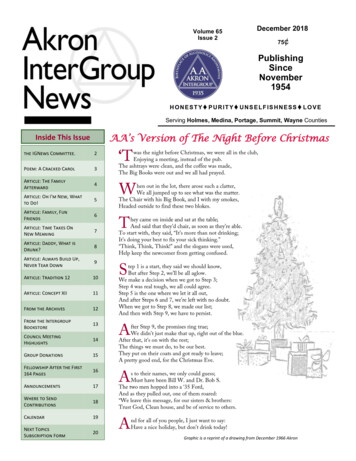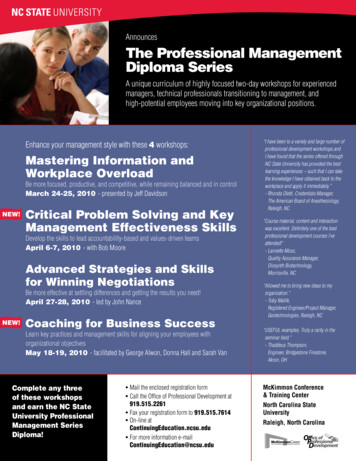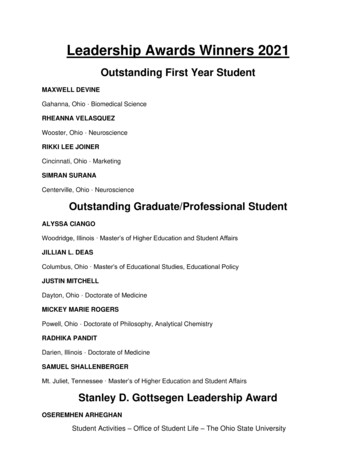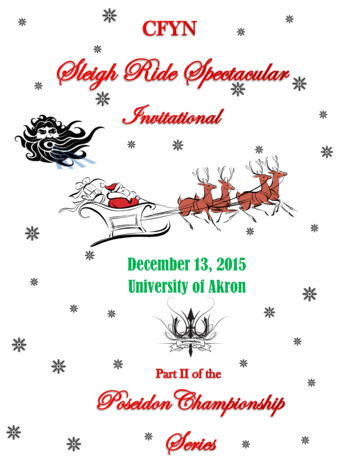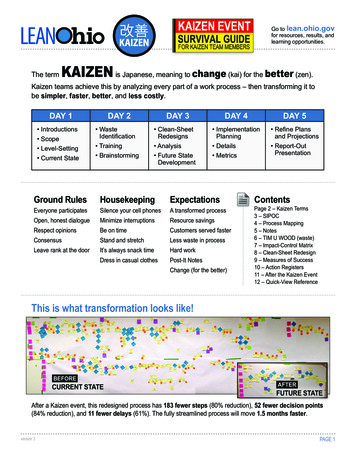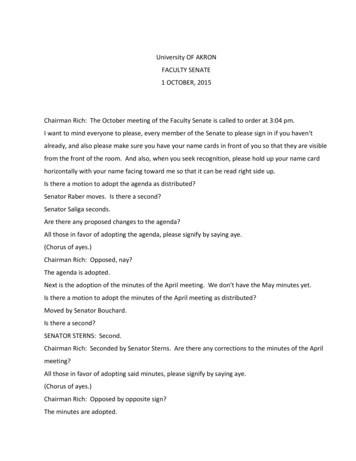
Transcription
University OF AKRONFACULTY SENATE1 OCTOBER, 2015Chairman Rich: The October meeting of the Faculty Senate is called to order at 3:04 pm.I want to mind everyone to please, every member of the Senate to please sign in if you haven'talready, and also please make sure you have your name cards in front of you so that they are visiblefrom the front of the room. And also, when you seek recognition, please hold up your name cardhorizontally with your name facing toward me so that it can be read right side up.Is there a motion to adopt the agenda as distributed?Senator Raber moves. Is there a second?Senator Saliga seconds.Are there any proposed changes to the agenda?All those in favor of adopting the agenda, please signify by saying aye.(Chorus of ayes.)Chairman Rich: Opposed, nay?The agenda is adopted.Next is the adoption of the minutes of the April meeting. We don't have the May minutes yet.Is there a motion to adopt the minutes of the April meeting as distributed?Moved by Senator Bouchard.Is there a second?SENATOR STERNS: Second.Chairman Rich: Seconded by Senator Sterns. Are there any corrections to the minutes of the Aprilmeeting?All those in favor of adopting said minutes, please signify by saying aye.(Chorus of ayes.)Chairman Rich: Opposed by opposite sign?The minutes are adopted.
2The next item is the remarks of the chairman.On today's agenda are the election of a second representative of the Faculty Senate to the GraduateCouncil: from the Academic Policies Committee a proposal for the creation of a Center for DataScience Analytics and Information Technology; from the Curriculum Review Committee a set ofcurriculum proposals for our approval; and from the Computing and Communication TechnologyCommittee a resolution concerning online student evaluations of instruction, consideration of whichwas postponed in the May meeting of the Senate.Another round of runoff elections in the College of Arts and Sciences has been completed. FiveFaculty Senate seats were filled as a result. There are two seats remaining to be filled, which willrequire yet another runoff.In addition, Parizad Dejbord Sawan of the College of Arts and Sciences has submitted herresignation from the Senate, so there is also an unexpired term to be filled by special election.I want to welcome three new Senators to the College of Arts and Sciences: Stacy Nofziger ofSociology who was elected to a full three year term, Robert Pope of English and Randall Mitchell ofBiology, both of whom were elected to unexpired one year terms.I also want to congratulate Senators Janet Klein and Phil Allen, both of whom were re elected.In addition to three elected representatives on the University Council, the Faculty Senate has tworepresentatives on each of the several committees of the University Council, one of which must be amember of the Senate and the other of which must not be a member of the Senate. Appointmentsof these representatives are made by the Faculty Senate's Executive Committee.There are currently two vacant positions: One is for a Faculty Senator on the University Council'sCommunications Committee. The other is on the University Council's Information TechnologyCommittee, and that is for a faculty member who is not a Senator.If you are interested in representing the Faculty Senate on the University Council's CommunicationsCommittee, please let me know. If you know of a faculty member who is not a member of this bodywho you think would be well suited to serving on the University Council's Information TechnologyCommittee, please let me know after confirming that he or she is willing to serve.
3Last Friday I attended a meeting of the Faculty Senate Chairs of the Universities of the Mid AmericanConference which was held on the campus of Eastern Michigan University in Ypsilanti, Michigan.The subject of the meeting was the escalating costs of intercollegiate athletics in general, andespecially football, and the strain that those costs impose on University budgets.In absolute terms, The University of Akron is behind only Eastern Michigan University and Buffalo inthe amount by which the University subsidizes intercollegiate athletics, according to publishedfigures. Akron, however, has the largest intercollegiate athletics budget in the MAC and is in themiddle of the pack in terms of the proportion of its intercollegiate athletics budget that theUniversity subsidizes. On average, MAC University subsidize their intercollegiate athletics budgetsin the neighborhood of 20 million annually.All of the representatives in attendance agreed that in this era of declining state support for publichigher education, the escalating costs of intercollegiate athletics pose a serious threat to theirrespective universities' ability to perform their core academic mission.This year all of the MAC universities decided to increase athletic scholarships to cover the so calledfull cost of attendance. At The University of Akron this increase costs the University approximately 700,000 annually, which is roughly the amount of money that was saved by the elimination of theUniversity's baseball team.An Eastern Michigan University faculty member in attendance at the meeting who was highlyknowledgeable about intercollegiate athletics, having previously been a football coach and anathletic director at various universities, predicted that escalation of the cost of the intercollegiateathletics will continue unless and until deliberate steps are taken by the universities to restrain thisescalation.There was also general agreement that the MAC universities ought to work together toward deescalation of costs and that the leadership of the faculties of those universities should take action toencourage their universities to pursue such a course and to education the public about theconsequences of the increasing cost of intercollegiate athletics.
4In the September Faculty Senate meeting I reported that the administration had promised toconclude the process of allocating full time faculty positions for the 2016 2017 academic year duringthe month of September. I said, and I quote, "The outcome of this decision process warrants closescrutiny by the faculty. The recent budget cuts represent an opportunity for the University to dowhat the faculty have long advocated: To allocate a greater proportion of the University's limitedresources to its core academic mission, which is performed largely by faculty." I continue to quote,"I expect to be able to report the results in our next meeting so that we can evaluate how well theuniversities has done at seizing this opportunity." End of quote.This past Tuesday, the administration announced the allocation of 55 full time faculty positions for2016 2017. Approximately one third of these positions are tenure track. The annual cost of these55 positions is estimated to be 4.5 million, which is somewhat less than the total amount of moneyalready in colleges' fiscal year 2016 budgets for faculty positions that became vacant due toretirements and other separations that occurred after January of 2015 for full time for temporaryfull time faculty positions that are to be made permanent and for positions that were authorizedbut not filled for this academic year. Positions that became vacant earlier than February 2015 wereremoved from the college budgets. None of the 55 positions are to be funded with money from the 10.4 million pool of funds for strategic initiatives.Essentially the allocation of these 55 positions means that so far the amount of money allocated tofull time faculty positions will be approximately what it was before, but vacant positions will befilled and temporary positions will become permanent, although these positions will not necessarilyremain in the same departments or colleges.The administration has indicated that a second round of position allocations will occur duringOctober and November in conjunction with meetings with college deans about implementation ofcollege strategic plans.These position requests will have to be justified in accordance with college strategic plans andpresumably will be funded largely from the 10.4 million strategic initiative pool. Any such positionallocations would represent new investment in full time faculty positions relative to the last fiscal
5year. It remains to be seen how many positions would be allocated in the next round.I am concerned about the timing of the second round of faculty position allocations. I hadpreviously urged that all of the allocation decisions be made by this past August 31 and theadministration had agreed to do so. When it became apparent that this deadline would not be met,a new deadline of September 15th was established. When I addressed this body on September 3rd,I already suspected that the new deadline would not be met and so I said only that I expected theallocations to be made in September.As it turned out, only the first round of allocations was made in September. We are told now thatthe second round will be completed in October and November, as I mentioned earlier. Even if thereis no further slippage in the schedule, second round of allocations will occur late enough thatsearches may not begin until December, or perhaps even January, and which in many academicdisciplines is too late to attract the strongest candidates. I have urged the administration to makethese decisions this month.I am also concerned about the fact that approximately two thirds of the 55 positions allocated arenot are nontenure track. Under the current rules, these faculty members have no job securitybeyond the end of each academic year. The University may decline to renew their appointments,not only for just cause or because the position is no longer needed, but for almost any reason or forno reason at all.Under such conditions of insecurity, academic freedom is more theoretical than real and theUniversity is unable to attract the high caliber faculty it can attract with tenure track appointments.Moreover, if appointments are made at the rank of lecturer, the service responsibilities areconcentrated among an ever decreasing number of tenure track faculty which necessarily detractsfrom the time they have to do research and teach.It must be noted that, to a large extent, the predominance of nontenure track appointmentsreflected a similar predominance in the position requests submitted by the deans, but it must alsobe noted that the deans appeared to believe that request for nontenure track positions would be
6more likely to be granted than would requests for tenure track positions.I hope that in the next round of faculty position allocations there will be a much higher proportionof tenure track positions, especially because the first round of allocation decisions addressed onlythe requests that were deemed to address clear, almost undebatable needs.This concludes my remarks.Next on the agenda is special announcements. I have one. Dr. Carlo A. Bersani, Professor Emeritusof Sociology, died September 24th at the age of 86. A native of Detroit, Michigan, Dr. Bersani joinedThe University of Akron faculty in 1965 after teaching at both Winona State and Drake Universities.He helped to establish the modern sociology program here as well as the Akron Kent State JointPh.D. Program, the M.A. Program, and the undergraduate degree programs in law enforcement andcorrections. He served as department head from 1976 to 1980. He earned a Ph.D. at Iowa StateUniversity, an M.A. at the University of Michigan, and a B.A. at Eastern Michigan University. Hecontinued to teach part time at The University of Akron until 2000.Would you all please rise? A moment of silence in memory of our deceased colleague.Thank you.The next item on the agenda is the report of the Executive Committee Secretary Schulze.SECRETARY SCHULZE: Since the Faculty Senate last met on September 3rd, the Faculty SenateExecutive Committee met twice by itself and once with the Provost. The Executive Committee firstmet on September 17th to conduct regular Senate business and to prepare for the meeting with theProvost. The EC made appointments to the Faculty Research Committee and the General EducationAdvisory Committee. We were updated on the Gen Ed Core 13, the appointment of the generaleducation coordinator, the allocation of graduate assistantships for 2015, the allocation ofpermanent full time faculty positions for 2016 and 2017. We discussed proposed changes to theacademic calendar, The University Press, strategic plans for libraries, the graduate school, and theHonors College. We also discussed the creation of an assessment coordinator position. The Provost
7updated the EC on falling enrollment.The Executive Committee next met on September 24th to discuss regular Senate business and toprepare the agenda for today's Faculty Senate meeting. The Executive Committee certified theelection of Philip Allen, Stacy Nofziger, Randall Mitchell, Robert Pope, Janet Klein, who were electedin a runoff election. We discussed University Council committee vacancies and Senate seatvacancies. We then planned the agenda for the upcoming Senate meeting.This concludes the Executive Committee's report.Chairman Rich: Are there any questions for Secretary Schulze about the Executive Committeereport?Thank you.Next on the agenda are the remarks of the President.President Scarborough.PRESIDENT SCARBOROUGH: Thank you, Chairman Rich.Senators, once again it's an honor to me to have the opportunity to be here and to make someopening remarks, and then if Chairman Rich allows, I'll be happy to answer whatever questions thatyou might have.Much of our time over the last few weeks has been, as Chairman Rich reported, finalizing the firstround process of approving the 55 new faculty positions. Chairman Rich did such a nice job ofsummarizing that, I'll skip the details for now and be available to answer questions about that aftermy opening remarks.Secondly, looking forward, we're particularly focusing on the Honors College. If you will recall, lastyear we worked with each of the colleges to develop college level strategic plans to work to in Artsand Science. Two academic portal colleges that we had not yet begun are the Honors College andthe Graduate School because we knew that there would be change in the leadership in those areas.With the arrival of a permanent dean for the Honors College, our intention now is to begin thatprocess with the Honors College so they too can have an updated, or in this case new, strategic planmoving forward. The Honors College represents a huge opportunity for the University. There'stremendous momentum with the Honors College. I believe in the last two years, enrollments havebeen 57 percent higher than they were beforehand. I think this year it was ten percent higher thanlast year. So there's tremendous momentum there.
8Coming out of the University's New Initiatives Summit that occurred in February and April of lastyear, one of the initiatives, among many, was to take the Honors College, to brand it, to give it anew strategic plan, and to grow, grow that college. This is a strategy that has been successfullyemployed by many universities across the country, Ole Miss, Arizona State, Michigan State, PennState, all that have branded and grown their Honors College so it becomes that wonderful liberalarts experience that many of us still hold as kind of the gold standard of undergraduate education.So our goal would be to find a donor, which we are working we are cultivating one at the moment,for a significant gift, to then put that name on the college to then brand it, and then to market in amore aggressive way a wonderful undergraduate experience for well prepared and generally wellresourced students, and in the case of well prepared and underresourced, we would have,obviously, very competitive financial aid packages that would allow students of all socioeconomicbackgrounds access to that experience.So this Honors College strategic planning session is a huge opportunity. We plan to involve theHonors College Advisory Council, which is constituted by the recommendations from each of thecolleges as being really the constituency group that will work with the team to develop that plan,much using the same kind of a process that we used with each of the colleges last, last academicyear.So that's a major new priority. As we kind of walk through the series of new initiatives that we haveimplemented since April, that is one that is targeted for implementation in the next, in the next fewmonths.In terms of kind of final comments in terms of opening remarks until we get to your questions, onething that kind of came to mind this morning is that many, many years ago there was a greatprofessor that I had who taught me the difference between cognitive conflict and affective conflict.And it was one of the great days in the classroom that you don't forget because it had greatapplication over my lifetime.The lecture began with the fact that cognitive conflict, or the active and aggressive debate of issuesby an able and informed team, is a huge contributor to great decision making, and the moral of thestory in this first part was to say if you are the leader of a team, one of the best things that you cando is assemble a diverse group of individuals with different competencies and abilities, providethem the information that they need, encourage them to engage in active debate, aggressive
9debate, and if that's done so in the right way, it'll lead to better decision making.So that's relatively straightforward. He said, however, the literature is pretty clear that if the samegroup engages in what's called affective conflict, it's actually not a positive contributor to decisionmaking, it becomes a negative, a more destructive force. And what's the difference betweenaffective and cognitive conflict is that affective conflict is not about the issues anymore, it becomesvery personal. It's when the members of the group turn away from the issues themselves and beginto focus on the differences of the people involved. When that happens, things become destructive.And so the implication for the leader of that team is to work diligently to make sure that everyoneunderstands the difference between the two and to keep it in the constructive, constructive arena.Now, what is it that would have caused me to be reminded of this? It's the clear evidence that wehave worked so hard in the last, I think, 15 months to take constituencies of this University and tobring them together in kind of a team environment, encouraging the active debate, dialogue,informed conversation around the issues that we face, the opportunities that we face, and trying toget it to a decision that is the best decision for our University.But recently there seems to have been a movement into the affective realm. And it's starting toshow signs, some fairly clearly evident signs. So I only close my opening remarks to say let us pulltogether, faculty, administrators, students, trustees, community members, to keep the debateconstructive, keep it in the cognitive realm. Don't let it be drawn into the shadows of affectiveconflict where things turn very personal and things get ugly. If we keep it in the cognitive realm,anything is possible for this University. If we allow it to go affective, if we allow it to be drawn intothe shadows of plots and plans, there's nothing that can work for our University.Chairman Rich: Thank you, Mr. President.Are there questions for the President?Senator Bouchard.SENATOR BOUCHARD: Yes. This is a follow-up question from last month. And at the time youtalked about how we had 190 incoming freshmen taking part in the Gen Ed Core.PRESIDENT SCARBOROUGH: Right.Chairman Rich: And at the time you promised to come back with numbers on how many of thesepeople who had applied for the first time after April 15th, when it was first announced. Do youhave that number?
10PRESIDENT SCARBOROUGH: Yeah, actually, of the 192 freshmen, we had two thirds of them, 128 ofthose, who paid their confirmation fee after April the 15th.SENATOR BOUCHARD: Okay.PRESIDENT SCARBOROUGH: The evidence there. So I think that is coincidentally exactly 66.6percent. Okay? So that is two thirds. But that was not an approximation, that's an actual count.SENATOR BOUCHARD: Okay. Because that was something you hadn't had last time. I just wantedthe data on that.PRESIDENT SCARBOROUGH: Right.SENATOR BOUCHARD: For next semester, since we're getting I mean, I know the semesters justzip along, we're only five weeks in, but we're already thinking about spring, are you going to be ablenext spring, assuming that the Gen Ed Core is still in place, are you going to be able to offer it theway it was originally intended, as a blended thing where students would actually have field researchand internships rather than just being a hundred percent online?PRESIDENT SCARBOROUGH: That is certainly my personal hope and my expectation, and mydirective would be make sure that we have both blended learning and online learning modalities foreach of those Gen Ed offerings. The advantage of the the advantage of the blended is obvious. Ithink that's the best pedagogy one can imagine.SENATOR BOUCHARD: Yes.PRESIDENT SCARBOROUGH: The advantage of the online is a tradeoff, to some extent, of quality forthe also highly valued characteristic of being convenient, and in particular in high schools wherethey would like us to provide dual enrollment opportunities for these general education courses,and it allows us to deliver that fairly efficiently and to widen our pipeline in terms of the studentsthat can be recruited in the University. What we obviously have to work on is to make sure thatthere is while it may not be the ideal level of quality that we wish, it needs to at least be at aminimum level of acceptable academic quality that all of us can feel good about.I think that's part of what we are trying to work on at the moment, these faculty who are workingon these first iterations, that they are working to achieve that level of quality. And I will tell you inthe one experience that I had in doing this at Toledo, it took them a year to develop it, teach it,amend it, to get it to the level that I think all of those faculty that continued to offer those courses
11were very excited about. But I do distinctly remember a day when five or six of those early facultymembers who developed and offered these courses for the first time came to a group meeting likethis and shared what their first experience was like and the positives and the negatives and howthey planned on changing the course for the next time, and so the conclusion that I walked awaywith, all the greatest planning in the world, it takes at least offering these once and experiencingonce until we get it to the level of quality that people start to more universally feel better about.SENATOR BOUCHARD: Okay. That does worry me. I'm on the General Education AdvisoryCommittee and what we are trying to do is to crank up the level, not talk about some minimalquality level. So let's see how that goes.And I do worry, just keep your eye on the keeping it blended, because as late as the day beforeclasses started the paper was still saying that these were going to be blended, which and therewas never an announcement, it just turned out that they weren't, and it was announced that therewere going to be no more than 25 students in a section and, whoops-a-doodle, there turned out tobe 40.PRESIDENT SCARBOROUGH: Yeah.SENATOR BOUCHARD: So, I mean, these are worrying things, especially since, according to thenumbers you just had, we have spent three quarters of a million dollars in lost tuition and gottenmaybe 120 new freshmen, and I'm not sure that, given the financial exigencies, that having maybe120 new freshmen who we aren't even sure are going to be able to perform well is worrisome. So Ihope that in the first Senate meeting after Christmas that you will be able to give us the figures onhow many of them actually passed the courses, because that's also another data point that we aregoing to need. But thank you for the information.PRESIDENT SCARBOROUGH: Sure. And I'm just hoping that that 700,000 doesn't stick because it'snot an easy calculation because in reality we have what's called the plateau. Any student takingabove 12 semester credit hours gets essentially the next, you know, several hours free of charge, sothis general education course sitting on top of a student who already is taking 12 hours, wewouldn't have received any additional incremental revenue to begin with. So I realize that's anestimate, but my guess is that's a pretty high estimate.SENATOR BOUCHARD: Okay.Chairman Rich: I just want to make sure that I understood correctly. It has been your directive that
12each of the Gen Ed Core courses to be offered in the spring would be offered in both blended andcompletely online modalities?PRESIDENT SCARBOROUGH: Yeah. It was actually my I don't know if "directive" was the wordmy express desire for that lastChairman Rich: I'm quite certain you used the word "directive" in this context, butPRESIDENT SCARBOROUGH: Yes, last semester. Yes, so to the extent I didn't see it this semester,the express desire takes on a little extra specificity going forward.Chairman Rich: It's been elevated to a directive?PRESIDENT SCARBOROUGH: Yeah. Well, I that's where I'm headed. I have not issued it yet.Chairman Rich: Ah.PRESIDENT SCARBOROUGH: Okay? I didn't think I needed to. Because really what we said from thevery beginning is that we do want both modalities, and I understood that once the dual enrollmentoption--but I am permanently committed, I don't know about you, I am personally committed tothis notion of a blended pedagogy. It's the pedagogy that I would want for myself. And I think it'sthe ideal in most disciplines, not all, but in many, many disciplines. So it is, it is certainly, in everyconversation with those developing this, it's being communicated as in the end we need to haveboth, we need to have both versions. That's what's been communicated. I have not characterized itin any of those meetings or any memos or e mails yet as this is a directive.Chairman Rich: Senator Nofziger.SENATOR NOFZIGER: Hi. You mentioned something about wanting to extend this to high schoolstudents, and I would like you to talk a little bit more about that and the logic of that-- and I framethis in the context of I was on the BCAS Online Committee, which was all about trying to push foronline courses, and what we found in that data, I don't know where that data ever ended up, butwhat we found in that data is the only ones who are successful in online courses are the higher levelstudents. The seniors, the juniors, the very self-motivated. The freshmen are going to struggle, so Iagree with Dr. Bouchard that I'd really like to see the successes of our freshmen before we evenconsider going to more problematic students of high school students, because I know at least in ourexperience of the distance learning courses in high schools, it's a nightmare, it's a mess. So couldyou talk a little bit more about what your logic is of extending it to that before you know success?
13PRESIDENT SCARBOROUGH: Well, Todd Rickel would be the better person to visit with, but myunderstanding is that they are targeting the more highly prepared high school students for as thetarget audience for this rollout. And because dual --because College Credit Plus has recentlyreceived the benefit of a better funding model from the state, there is a lot of interest in kind ofexpanding dual enrollment in College Credit Plus, not only because the funding model is a little bitbetter, because it opened, it broadened the recruitment pipeline for greater numbers of wellprepared students in the process. And if they have good experience with us in a dual enrollment, ifwe can engage them in a positive conversation, theoretically it makes it a little easier then to recruitthat student to the University. So I believe that's the intention, but, again, in terms of greater levelsand specifics, we'll have to get you someone else who is closer to the ground level to explain that.But my understanding, the target audience is the better prepared high school student looking for adual enrollment option.Chairman Rich: Senator Sterns.SENATOR STERNS: Mr. Chair, I'd like to ask the President, you have been talking for many monthsnow about the changing landscape of higher education. Even so, yesterday I was surprised to hearon Public Broadcasting the announcement of the legislature becoming even more involved insuggesting cost cutting and reductions. Can you tell us what's come down to you about that?Because it just makes matters worse, I guess.PRESIDENT SCARBOROUGH: Yeah, I can speak, I can speak broadly to this reality. I mean for quitesome time I think I have known, I think perhaps many of you have known, that the governor hadappointed a task force looking to generate ideas about how public higher education could be moreaffordable and cost effective. And he appointed a number of people to that commission, and it washeaded, the commission was headed by the chief financial officer at Ohio State University. And sothey had been meeting for quite some time.At the regular meetings of University presidents convened by the Inter University Council inColumbus, we have been receiving updates on the nature of those conversations. Frankly, therewasn't anything being reported that I hadn't heard before. To me, it didn't represent kind of asignificant shift in one direction or the other. The draft report that I saw, although I have not seenthe final report, I would assume it's pretty close to the draft report that I saw, really was just alisting of best practices, and so I think perhaps a next step would be for Mike and I to meet with
14Faculty Senate Executive Committee and say let's look through the report oursel
Ph.D. Program, the M.A. Program, and the undergraduate degree programs in law enforcement and corrections. He served as department head from 1976 to 1980. He earned a Ph.D. at Iowa State University, an M.A. at the University of Michigan, and a B.A. at Eastern Michigan University. He continued to teach part time at The University of Akron until .


